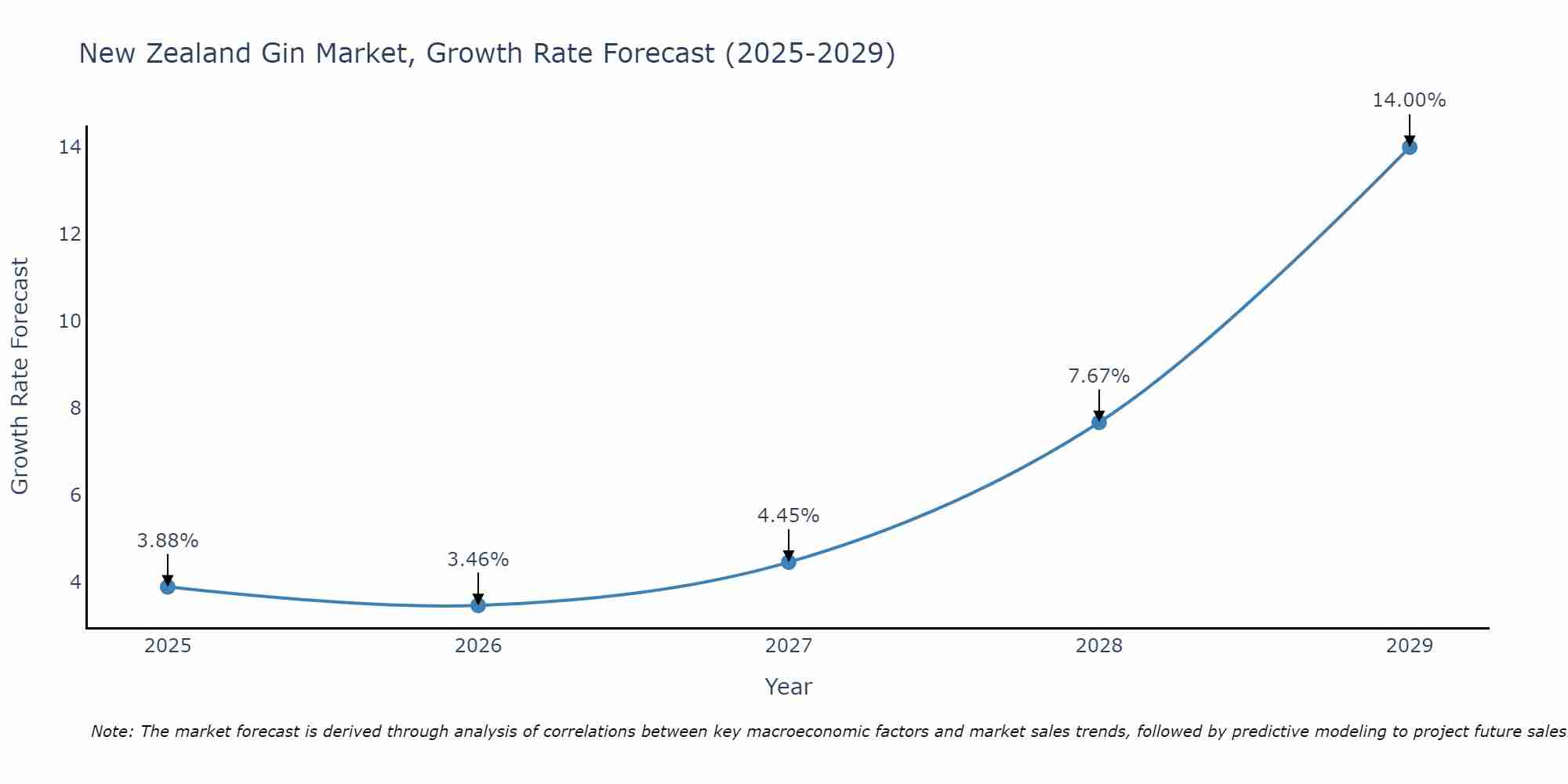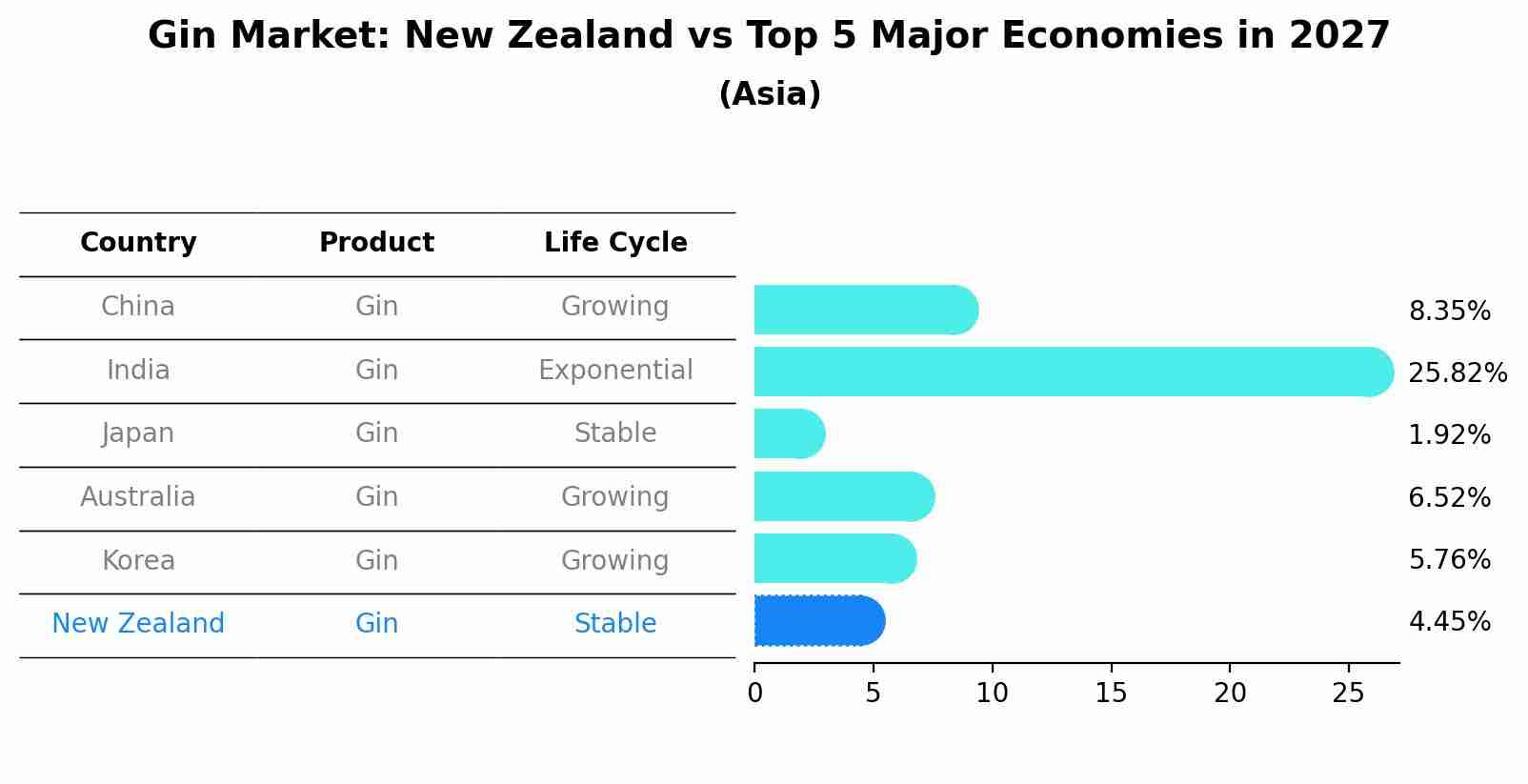New Zealand Gin Market (2025-2031) | Growth, Analysis, Segmentation, Value, Companies, Forecast, Revenue, Industry, Size, Outlook, Share & Trends
| Product Code: ETC4673299 | Publication Date: Nov 2023 | Updated Date: Apr 2025 | Product Type: Market Research Report | |
| Publisher: 6Wresearch | Author: Shubham Deep | No. of Pages: 60 | No. of Figures: 30 | No. of Tables: 5 |
New Zealand Gin Market Size Growth Rate
The New Zealand Gin Market is projected to witness mixed growth rate patterns during 2025 to 2029. The growth rate starts at 3.88% in 2025 and reaches 14.00% by 2029.

Gin Market: New Zealand vs Top 5 Major Economies in 2027 (Asia)
By 2027, the Gin market in New Zealand is anticipated to reach a growth rate of 4.45%, as part of an increasingly competitive Asia region, where China remains at the forefront, supported by India, Japan, Australia and South Korea, driving innovations and market adoption across sectors.

New Zealand Gin Market Overview
In New Zealand, the gin market reflects a dynamic landscape characterized by innovation, craftsmanship, and evolving consumer tastes. Gin, a versatile spirit infused with botanicals such as juniper, citrus, and herbs, enjoys a resurgence in popularity driven by craft distilleries, cocktail culture, and premiumization trends. The market offers a diverse range of gin styles, flavors, and expressions, catering to connoisseurs, mixologists, and casual drinkers alike. With a focus on quality ingredients, artisanal production methods, and creative branding, the gin market in New Zealand.
Drivers of the market
The gin market in New Zealand is experiencing significant growth driven by changing consumer preferences, growing cocktail culture, and the emergence of craft distilleries. Gin, a spirit distilled from juniper berries and botanicals, has witnessed a resurgence in popularity worldwide, with consumers seeking premium and artisanal gin products with unique flavors, botanical blends, and artisanal production methods. The increasing demand for craft spirits, artisanal cocktails, and experiential drinking occasions fuels the expansion of the gin market, with distillers focusing on product innovation, small-batch production, and storytelling to differentiate their brands and cater to diverse consumer tastes. Moreover, the rising trend of gin tourism, cocktail bars, and gin-related events further stimulates market growth, with consumers exploring new flavors, brands, and drinking experiences in the vibrant gin scene.
Challenges of the market
The Gin market in New Zealand encounters challenges associated with market saturation, brand differentiation, and changing consumer preferences. Despite the popularity of craft gins and unique botanical blends, the market faces competition from established brands and alternative spirits. Moreover, regulatory compliance, distribution channels, and marketing strategies are critical factors influencing market growth and profitability in a dynamic industry landscape.
Government Policy of the market
Government regulations oversee alcohol production, labeling, and marketing in the New Zealand gin market. Compliance with licensing, taxation, and safety standards is enforced to ensure consumer safety and fair competition.
Key Highlights of the Report:
- New Zealand Gin Market Outlook
- Market Size of New Zealand Gin Market, 2024
- Forecast of New Zealand Gin Market, 2031
- Historical Data and Forecast of New Zealand Gin Revenues & Volume for the Period 2021-2031
- New Zealand Gin Market Trend Evolution
- New Zealand Gin Market Drivers and Challenges
- New Zealand Gin Price Trends
- New Zealand Gin Porter`s Five Forces
- New Zealand Gin Industry Life Cycle
- Historical Data and Forecast of New Zealand Gin Market Revenues & Volume By Product Type for the Period 2021-2031
- Historical Data and Forecast of New Zealand Gin Market Revenues & Volume By London Dry Gin for the Period 2021-2031
- Historical Data and Forecast of New Zealand Gin Market Revenues & Volume By Plymouth Gin for the Period 2021-2031
- Historical Data and Forecast of New Zealand Gin Market Revenues & Volume By Genever/Dutch Gin for the Period 2021-2031
- Historical Data and Forecast of New Zealand Gin Market Revenues & Volume By Old Tim Gin for the Period 2021-2031
- Historical Data and Forecast of New Zealand Gin Market Revenues & Volume By New American Gin for the Period 2021-2031
- Historical Data and Forecast of New Zealand Gin Market Revenues & Volume By Production Method for the Period 2021-2031
- Historical Data and Forecast of New Zealand Gin Market Revenues & Volume By Pot Distilled Gin for the Period 2021-2031
- Historical Data and Forecast of New Zealand Gin Market Revenues & Volume By Column Distilled Gin for the Period 2021-2031
- Historical Data and Forecast of New Zealand Gin Market Revenues & Volume By Compound Gin for the Period 2021-2031
- Historical Data and Forecast of New Zealand Gin Market Revenues & Volume By Distribution Channel for the Period 2021-2031
- Historical Data and Forecast of New Zealand Gin Market Revenues & Volume By Hypermarkets and Supermarkets for the Period 2021-2031
- Historical Data and Forecast of New Zealand Gin Market Revenues & Volume By Specialty Stores for the Period 2021-2031
- Historical Data and Forecast of New Zealand Gin Market Revenues & Volume By Drug Stores for the Period 2021-2031
- Historical Data and Forecast of New Zealand Gin Market Revenues & Volume By Online Channel for the Period 2021-2031
- Historical Data and Forecast of New Zealand Gin Market Revenues & Volume By HoReCa for the Period 2021-2031
- Historical Data and Forecast of New Zealand Gin Market Revenues & Volume By Others for the Period 2021-2031
- New Zealand Gin Import Export Trade Statistics
- Market Opportunity Assessment By Product Type
- Market Opportunity Assessment By Production Method
- Market Opportunity Assessment By Distribution Channel
- New Zealand Gin Top Companies Market Share
- New Zealand Gin Competitive Benchmarking By Technical and Operational Parameters
- New Zealand Gin Company Profiles
- New Zealand Gin Key Strategic Recommendations
Frequently Asked Questions About the Market Study (FAQs):
1 Executive Summary |
2 Introduction |
2.1 Key Highlights of the Report |
2.2 Report Description |
2.3 Market Scope & Segmentation |
2.4 Research Methodology |
2.5 Assumptions |
3 New Zealand Gin Market Overview |
3.1 New Zealand Country Macro Economic Indicators |
3.2 New Zealand Gin Market Revenues & Volume, 2021 & 2031F |
3.3 New Zealand Gin Market - Industry Life Cycle |
3.4 New Zealand Gin Market - Porter's Five Forces |
3.5 New Zealand Gin Market Revenues & Volume Share, By Product Type, 2021 & 2031F |
3.6 New Zealand Gin Market Revenues & Volume Share, By Production Method, 2021 & 2031F |
3.7 New Zealand Gin Market Revenues & Volume Share, By Distribution Channel, 2021 & 2031F |
4 New Zealand Gin Market Dynamics |
4.1 Impact Analysis |
4.2 Market Drivers |
4.3 Market Restraints |
5 New Zealand Gin Market Trends |
6 New Zealand Gin Market Segmentations |
6.1 New Zealand Gin Market, By Product Type |
6.1.1 Overview and Analysis |
6.1.2 New Zealand Gin Market Revenues & Volume, By London Dry Gin, 2021-2031F |
6.1.3 New Zealand Gin Market Revenues & Volume, By Plymouth Gin, 2021-2031F |
6.1.4 New Zealand Gin Market Revenues & Volume, By Genever/Dutch Gin, 2021-2031F |
6.1.5 New Zealand Gin Market Revenues & Volume, By Old Tim Gin, 2021-2031F |
6.1.6 New Zealand Gin Market Revenues & Volume, By New American Gin, 2021-2031F |
6.2 New Zealand Gin Market, By Production Method |
6.2.1 Overview and Analysis |
6.2.2 New Zealand Gin Market Revenues & Volume, By Pot Distilled Gin, 2021-2031F |
6.2.3 New Zealand Gin Market Revenues & Volume, By Column Distilled Gin, 2021-2031F |
6.2.4 New Zealand Gin Market Revenues & Volume, By Compound Gin, 2021-2031F |
6.3 New Zealand Gin Market, By Distribution Channel |
6.3.1 Overview and Analysis |
6.3.2 New Zealand Gin Market Revenues & Volume, By Hypermarkets and Supermarkets, 2021-2031F |
6.3.3 New Zealand Gin Market Revenues & Volume, By Specialty Stores, 2021-2031F |
6.3.4 New Zealand Gin Market Revenues & Volume, By Drug Stores, 2021-2031F |
6.3.5 New Zealand Gin Market Revenues & Volume, By Online Channel, 2021-2031F |
6.3.6 New Zealand Gin Market Revenues & Volume, By HoReCa, 2021-2031F |
6.3.7 New Zealand Gin Market Revenues & Volume, By Others, 2021-2031F |
7 New Zealand Gin Market Import-Export Trade Statistics |
7.1 New Zealand Gin Market Export to Major Countries |
7.2 New Zealand Gin Market Imports from Major Countries |
8 New Zealand Gin Market Key Performance Indicators |
9 New Zealand Gin Market - Opportunity Assessment |
9.1 New Zealand Gin Market Opportunity Assessment, By Product Type, 2021 & 2031F |
9.2 New Zealand Gin Market Opportunity Assessment, By Production Method, 2021 & 2031F |
9.3 New Zealand Gin Market Opportunity Assessment, By Distribution Channel, 2021 & 2031F |
10 New Zealand Gin Market - Competitive Landscape |
10.1 New Zealand Gin Market Revenue Share, By Companies, 2024 |
10.2 New Zealand Gin Market Competitive Benchmarking, By Operating and Technical Parameters |
11 Company Profiles |
12 Recommendations | 13 Disclaimer |
- Single User License$ 1,995
- Department License$ 2,400
- Site License$ 3,120
- Global License$ 3,795
Search
Related Reports
- Portugal Electronic Document Management Market (2025-2031) | Strategy, Consumer Insights, Analysis, Investment Trends, Opportunities, Growth, Size, Share, Industry, Revenue, Segments, Value, Segmentation, Supply, Forecast, Restraints, Outlook, Competition, Drivers, Trends, Demand, Pricing Analysis, Competitive, Strategic Insights, Companies, Challenges
- France Electronic Document Management Market (2025-2031) | Strategy, Consumer Insights, Analysis, Investment Trends, Opportunities, Growth, Size, Share, Industry, Revenue, Segments, Value, Segmentation, Supply, Forecast, Restraints, Outlook, Competition, Drivers, Trends, Demand, Pricing Analysis, Competitive, Strategic Insights, Companies, Challenges
- Portugal Occupational Health & Safety Services Market (2025-2031) | Strategy, Consumer Insights, Analysis, Investment Trends, Opportunities, Growth, Size, Share, Industry, Revenue, Segments, Value, Segmentation, Supply, Forecast, Restraints, Outlook, Competition, Drivers, Trends, Demand, Pricing Analysis, Competitive, Strategic Insights, Companies, Challenges
- Netherlands Occupational Health and Safety Services Market (2025-2031) | Strategy, Consumer Insights, Analysis, Investment Trends, Opportunities, Growth, Size, Share, Industry, Revenue, Segments, Value, Segmentation, Supply, Forecast, Restraints, Outlook, Competition, Drivers, Trends, Demand, Pricing Analysis, Competitive, Strategic Insights, Companies, Challenges
- Belgium and Luxembourg Facility Management Market (2025-2031) | Strategy, Consumer Insights, Analysis, Investment Trends, Opportunities, Growth, Size, Share, Industry, Revenue, Segments, Value, Segmentation, Supply, Forecast, Restraints, Outlook, Competition, Drivers, Trends, Demand, Pricing Analysis, Competitive, Strategic Insights, Companies, Challenges
- Russia Women Intimate Apparel Market (2025-2031) | Strategy, Consumer Insights, Analysis, Investment Trends, Opportunities, Growth, Size, Share, Industry, Revenue, Segments, Value, Segmentation, Supply, Forecast, Restraints, Outlook, Competition, Drivers, Trends, Demand, Pricing Analysis, Competitive, Strategic Insights, Companies, Challenges
- Africa Chocolate Market (2025-2031) | Size, Share, Trends, Growth, Revenue, Analysis, Forecast, industry & Outlook
- Global Hydroxychloroquine And Chloroquine Market (2025-2031) | Industry, Trends, Size, Outlook, Growth, Value, Companies, Revenue, Analysis, Share, Forecast
- Saudi Arabia Plant Maintenance Market (2025-2031) | Industry, Size, Growth, Revenue, Value, Companies, Forecast, Analysis, Share & Trends
- Taiwan Electric Truck Market (2025-2031) | Outlook, Industry, Revenue, Size, Forecast, Growth, Analysis, Share, Companies, Value & Trends
Industry Events and Analyst Meet
Our Clients
Whitepaper
- Middle East & Africa Commercial Security Market Click here to view more.
- Middle East & Africa Fire Safety Systems & Equipment Market Click here to view more.
- GCC Drone Market Click here to view more.
- Middle East Lighting Fixture Market Click here to view more.
- GCC Physical & Perimeter Security Market Click here to view more.
6WResearch In News
- Doha a strategic location for EV manufacturing hub: IPA Qatar
- Demand for luxury TVs surging in the GCC, says Samsung
- Empowering Growth: The Thriving Journey of Bangladesh’s Cable Industry
- Demand for luxury TVs surging in the GCC, says Samsung
- Video call with a traditional healer? Once unthinkable, it’s now common in South Africa
- Intelligent Buildings To Smooth GCC’s Path To Net Zero













